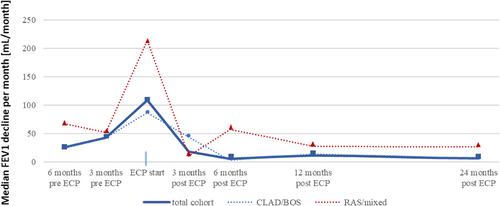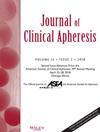Early extracorporeal photopheresis treatment is associated with better survival in patients with chronic or recurrent acute lung allograft dysfunction
Abstract
Background
Due to development of chronic lung allograft dysfunction (CLAD), prognosis for patients undergoing lung transplantation (LTx) is still worse compared to other solid organ transplant recipients. Treatment options for slowing down CLAD progression are scarce with extracorporeal photopheresis (ECP) as an established rescue therapy. The aim of the study was to identify characteristics of responders and non-responders to ECP treatment, assess their survival, lung function development and by that define the subset of patients who should receive early ECP treatment.
Methods
We performed a retrospective study of all LTx patients receiving ECP treatment at the University Hospital Zurich between January 2010 and March 2020. Patients were followed-up for a maximum period of 5 years. Mortality and lung function development were assessed by CLAD stage and by CLAD subtype before initiation of ECP treatment.
Results
Overall, 105 patients received at least one ECP following LTx. A total of 57 patients (61.3%) died within the study period with a median survival of 15 months. Mortality was 57% for patients who started ECP at CLAD1, 39% for CLAD2, 93% for CLAD3, and 90% for CLAD4 (p < 0.001). Survival and lung function development was best in young patients at early CLAD stages 1 and 2. Response to ECP treatment was worst in patients with CLAD-RAS/mixed subtype (14.3%) and patients with ECP initiation in CLAD stages 3 (7.1%) and 4 (11.1%). Survival was significantly better in a subset of patients with recurrent acute allograft dysfunction and earlier start of ECP treatment (105 vs 15 months).
Conclusion
In this retrospective analysis of a large group of CLAD patients treated with ECP after LTx, early initiation of ECP was associated with better long-term survival. Besides a subset of patients suffering of recurrent allograft dysfunction, especially a subset of patients defined as responders showed an improved response rate and survival, suggesting that ECP should be initiated in early CLAD stages and young patients. ECP might therefore prevent long-term disease progression even in patients with CLAD refractory to other treatment options and thus prevent or delay re-transplantation.


 求助内容:
求助内容: 应助结果提醒方式:
应助结果提醒方式:


